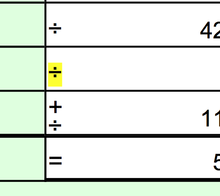除号
除以号(符号:÷,英語:obelus,复数:obeli)是由一根短横线和横线两侧的两点构成的符号,主要用来表示数学的除法运算。
历史[编辑]

英语中除号的单词“obelus”来自于希腊语ὀβελός,表示尖锐的棍棒,这与英语中表示方尖碑(Obelisk)的词源相同。
这个符号原本在古代手稿中应用于标记被损坏或虚假的文章,由阿里斯塔克[註 1]发明以标记荷马作品中的疑问,常被用来标记福音书手稿中那些有疑问的章节,比如遭受质疑的约翰福音中的章节。而如今这种用法已经被弃置不用[1]。
1544年,德国数学家米夏埃尔·施蒂费尔于其出版的《整数算术》(Arithmetica integra)中以一个或一对括号作除号,如以“8 ) 24”或“8 ) 24 (”表示“24 ÷ 8”;威廉·奥特雷德则以“a ) b ( c”来表示“b ÷ a = c”;J.马洪(1701年)则以“D ) A + B - C”表示“( A + B - C )÷D”[2]。至1545年,施蒂费尔又改以大写德文字母D表示除,其后,斯蒂文也采用了这符号,他以“5②Dsec①Mter②”表示,而戈里马德(1751年)则以反写字母“Ɑ”表示除。另外,昆尼亚于1790年出版的《数学原理》中,以平放的小写字母p表示除[3]。
现在被广泛使用的除法运算符号“÷”被称为雷恩记号,它首次作为除号被使用,是在瑞士学者约翰·海因里希·雷恩1659年所著的一本代数學书中[4]。但其實真正的引入也有可能归功于这本书的编辑约翰·佩尔[5]。1668年,该书被译成英文,才逐渐被人们所认识和接受,得以流行起来,沿用至今。
因为“÷”号在欧洲大陆曾长期被用来表示减法,为了与减法区别,德国数学家戈特弗里德·莱布尼茨於他的一篇論文《組合的藝術》(Dissertatio de arte combinatoria)內首以“∶”作除号,与当时流行的比号一致。现在世界上有些国家仍然用“∶”做除号[3]。
至于为何要使用“÷”作为除号则有两种说法:一种说法是,该符号代表除法以分数的形式来表示,一的上方和下方各加“.”,分别代表分子分母;另一种说法是,不以分数表示时,横线上下的“.”是用来与“-”区别的符号[4]。
使用[编辑]

除号在算术中用来表示两个数相除。例如:
上面等式中,a为被除数,b为除数,得到c为商。
在部分文化中,“÷”可以被用作表示范围(如1÷10,表示1到10的范围),甚至可以被用作减号[5]。
输入[编辑]
在操作系统Microsoft Windows中,除号可以通过按住Alt键,同时按数字小键盘0247输入,或者同时按AltGr键、shift键和“+ =”键输入。
在操作系统Mac OS中,可通过Option键加上“/”键输入。
在Unicode中,“÷”的编码是U+00F7。在HTML中,它可以通过编码÷或者÷(在HTML 3.2),或者是÷输入。在LaTeX中,可以使用\div来表示除号。
注释[编辑]
- ^ 据推测可能是萨莫色雷斯的阿里斯塔库斯。
参考文献[编辑]
- ^ Burnett Hillman Streeter. The Four Gospels: A Study of Origins, Treating of the Manuscript Tradition, Sources, Authorship, & Dates. Macmillan. 1936.
- ^ Earliest Uses of Symbols of Operation. [2013-02-26]. (原始内容存档于2013-03-02).
- ^ 3.0 3.1 除號. 港澳信義會慕德中學. [2013-02-26]. (原始内容存档于2005-02-13).
- ^ 4.0 4.1 陈丹丹. 除号的由来. 数学小灵通:小学1-2年级版. 2011, (4).
- ^ 5.0 5.1 Michael Quinion. SIGNS FOR SUMS. [2013-02-26]. (原始内容存档于2013-01-20).
外部連結[编辑]
| 查看维基词典中的词条「÷」。 |
| 算术运算 | ||||||||||||||||||||||||||||||||||||||||||||||||
|
||||||||||||||||||||||||||||||||||||||||||||||||















![{\displaystyle \scriptstyle {\sqrt[{\text{根 指 数 }}]{\scriptstyle {\text{被 开 方 数 }}}}\,=\,}](https://wikimedia.org/api/rest_v1/media/math/render/svg/129356d757065c14aa96f75e3c93198f2e4fba94)






